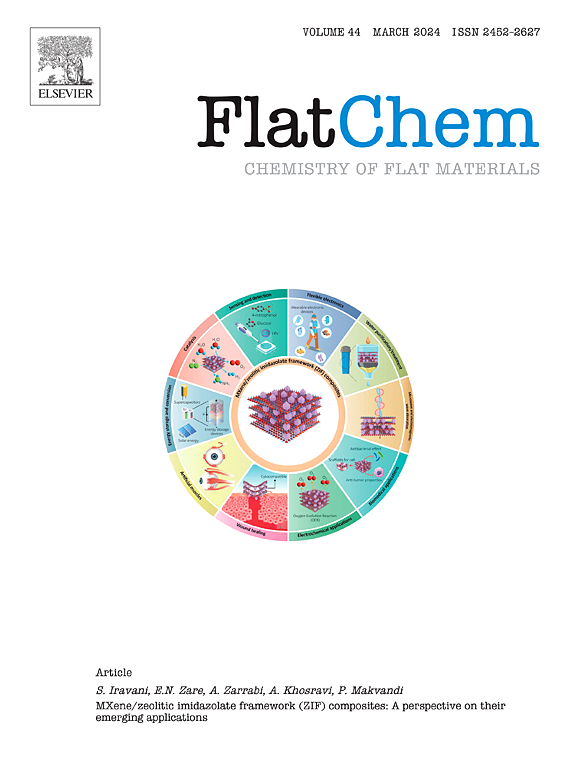Assembly of Ti3C2 MXene and SBA-15 templated mesoporous NiFe2O4 as an anode for lithium-ion battery
IF 6.2
3区 材料科学
Q2 CHEMISTRY, PHYSICAL
引用次数: 0
Abstract
This study reports on the fabrication and assembly of Ti3C2 MXene and mesoporous NiFe2O4 (m-NiFe2O4) as anode material for Lithium-ion battery (LIB). Here, Ti3C2 MXene was prepared using an etching and exfoliating process. Meanwhile, the mesoporous feature of NiFe2O4 was fabricated via nanocasting method using SBA-15 as a hard template. Based on the result, the integration of the two materials via hydrothermal method was found to demonstrate a synergistic effect in facilitating the migration of Li ions, which resulted in a significant increase in the initial discharge capacity of 1383 mA h g−1 and Coulombic efficiency of 95 %. Such enhancement was believed to have originated not only from the high surface area of m-NiFe2O4 (168.27 m2/g), which was mainly due to its mesoporous feature, but also the unique physicochemical properties and conductivity of Ti3C2 MXene. Besides, theoretical calculation using Density Functional Theory (DFT) also revealed that the adsorption energy of lithium atoms at the composite's surface was found to be more negative than that of individual materials. This suggests that the synergy between the two materials provides a more favorable environment for lithium to be intercalated at the anode, ultimately leading to increased battery performance.

ti3c2mxene与SBA-15模板化介孔NiFe2O4组装成锂离子电池负极材料
本文报道了ti3c2mxene和介孔NiFe2O4 (m-NiFe2O4)作为锂离子电池负极材料的制备和组装。本文采用蚀刻和剥离工艺制备了Ti3C2 MXene。同时,以SBA-15为硬模板,采用纳米浇铸法制备了NiFe2O4的介孔结构。结果表明,通过水热法将两种材料整合在一起,对Li离子的迁移具有协同效应,使电池的初始放电容量达到1383 mA h g−1,库仑效率达到95%。这种增强不仅源于m-NiFe2O4的高表面积(168.27 m2/g),这主要是由于它的介孔特性,还与Ti3C2 MXene独特的物理化学性质和导电性有关。此外,利用密度泛函理论(DFT)进行理论计算也发现,锂原子在复合材料表面的吸附能比单个材料的吸附能更负。这表明两种材料之间的协同作用为锂在阳极插入提供了更有利的环境,最终导致电池性能的提高。
本文章由计算机程序翻译,如有差异,请以英文原文为准。
求助全文
约1分钟内获得全文
求助全文
来源期刊

FlatChem
Multiple-
CiteScore
8.40
自引率
6.50%
发文量
104
审稿时长
26 days
期刊介绍:
FlatChem - Chemistry of Flat Materials, a new voice in the community, publishes original and significant, cutting-edge research related to the chemistry of graphene and related 2D & layered materials. The overall aim of the journal is to combine the chemistry and applications of these materials, where the submission of communications, full papers, and concepts should contain chemistry in a materials context, which can be both experimental and/or theoretical. In addition to original research articles, FlatChem also offers reviews, minireviews, highlights and perspectives on the future of this research area with the scientific leaders in fields related to Flat Materials. Topics of interest include, but are not limited to, the following: -Design, synthesis, applications and investigation of graphene, graphene related materials and other 2D & layered materials (for example Silicene, Germanene, Phosphorene, MXenes, Boron nitride, Transition metal dichalcogenides) -Characterization of these materials using all forms of spectroscopy and microscopy techniques -Chemical modification or functionalization and dispersion of these materials, as well as interactions with other materials -Exploring the surface chemistry of these materials for applications in: Sensors or detectors in electrochemical/Lab on a Chip devices, Composite materials, Membranes, Environment technology, Catalysis for energy storage and conversion (for example fuel cells, supercapacitors, batteries, hydrogen storage), Biomedical technology (drug delivery, biosensing, bioimaging)
 求助内容:
求助内容: 应助结果提醒方式:
应助结果提醒方式:


